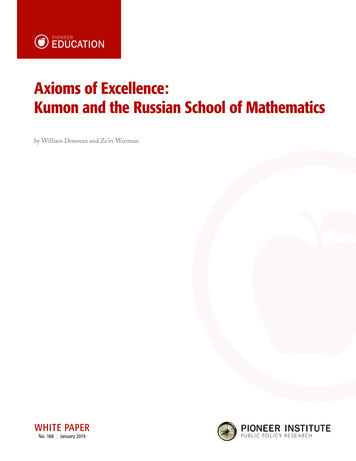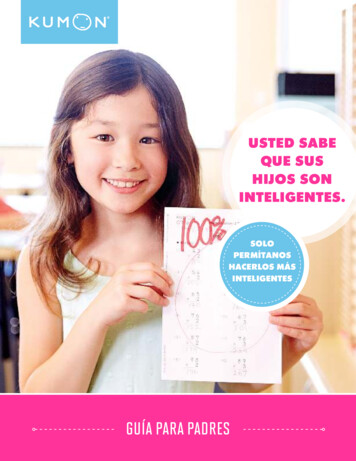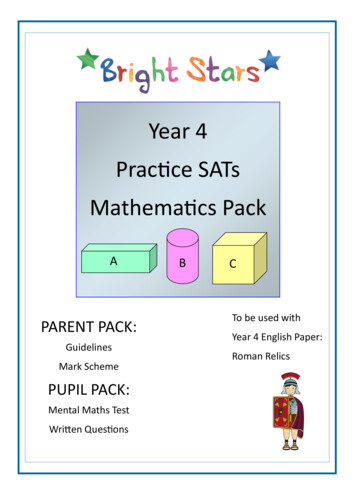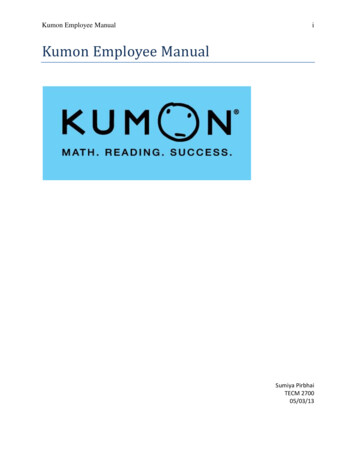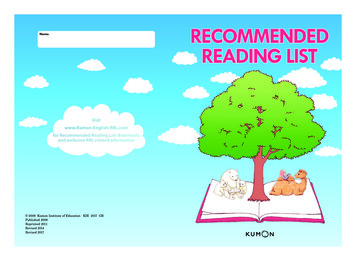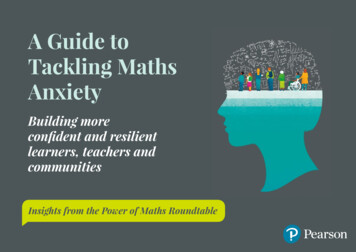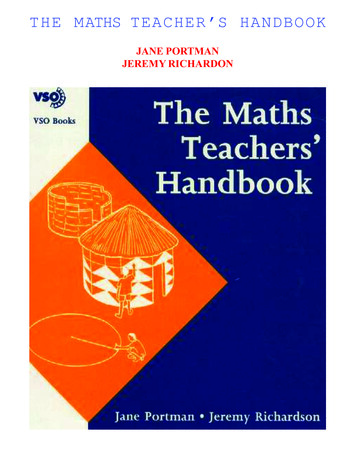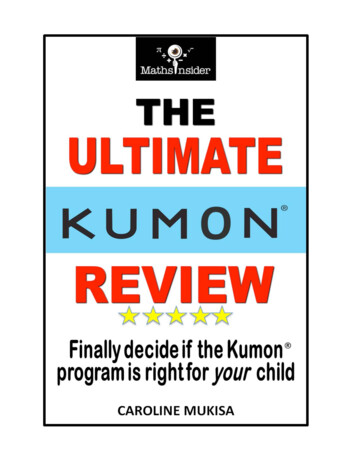
Transcription
The Ultimate Kumon Review-Finally decide if the Kumon program is right for your childCaroline Mukisa
The Ultimate Kumon Review - Finally decide if the Kumon program is right for your childCopyright: Caroline MukisaPublished: December 2011The right of Caroline Mukisa to be identified as author of this Work has been asserted by her inaccordance with sections 77 and 78 of the Copyright, Designs and Patents Act 1988.All rights reserved. No part of this publication may be reproduced, stored in retrieval system, copied inany form or by any means, electronic, mechanical, photocopying, recording or otherwise transmittedwithout written permission from the publisher. You must not circulate this book in any format.Find more math tips at the author’s website www.mathsinsider.com or @mathsinsider
WHO AM I AND WHAT CAN I TELL YOU ABOUT KUMON?So who am I? Well my name is Caroline Mukisa. I studied civil engineering at the University ofLondon, Imperial College and after working as an engineer for 1 year I went on to do teacher training. Itrained to be a math teacher at Cambridge University. After that I taught high school math for severalyears to 11 to 18 year olds. I am also a mother of 4, 2 preteens and 2 preschoolers.My main qualification for writing this book is that I ran a Kumon center in Central London, for 3 years.In addition I run the Math Insider website at www.mathsinsider.com, where I offer tips and practicaladvice to help parents guide their children to math success.Based on my time running a Kumon center; the interactions I’ve had with fellow parents, teachers andreaders of my blog; and reading and answering lots of queries about Kumon on parenting messageboards; I realized that there was a desperate need for families to fully work through the different prosand cons of Kumon, the world’s largest supplementary math program. It’s obvious that Kumon workswell for some families and is truly a waste of time, money and energy for others. After reading thisbook and answering the questions at the back of the book, you’ll be in an excellent position to be ableto decide if Kumon is the right choice for your child.
ABOUT KUMONFirst, a bit of background about Kumon. It started in 1954 in Japan, with a teacher named Toru Kumon.He was a father and a math teacher and like many parents he was frustrated with the math work his 2ndgrade son was doing at school. His son didn’t seem to be performing very well or progressing. ToruKumon prepared some homemade math worksheets for his son and soon his son started doing reallywell at math at school. News of his son’s math improvement quickly got round the neighbourhood andthe neighbours wanted to know what special work Toru Kumon was doing with his son. He startedshowing the worksheets to a few of his the neighbors and soon the demand was so much he set up hisfirst Kumon Center in 1955. Toru Kumon’s son was doing calculus by the time he reached 6th grade.Over the following years Kumon centres started opening up throughout Japan and reached the UnitedStates in 1974.Now, there have been around 20 million students who have gone through the Kumon program. Withabout 4 million students currently signed up to the math or reading Program. Furthermore Kumonreally is a worldwide program with 26,000 centers in 44 countries.
THE CURRICULUMHere’s an overview of the Kumon curriculum which will help you understand how it works.Level 7A: Counting to 10Level 6A: Counting to 30Level 5A: Line drawing, number puzzles to 50Level 4A: Reciting and writing numbers up to 220Level 3A: Adding with numbers up to 5Level 2A: Adding with numbers up to 10, subtracting with numbers up to 9Level A: Horizontal addition and subtraction of larger numbersLevel B: Vertical addition and subtractionLevel C: Multiplication, divisionLevel D: Long multiplication, long division, introduction to fractionsLevel E: FractionsLevel F: Four operations of fractions, decimalsLevel G: Positive/negative numbers, exponents, introduction to algebraLevel H: Linear/simultaneous equations, inequalities, functions and graphsLevel I: Factorization, square roots, quadratic equations, Pythagorean theoremLevel J: Advanced algebraLevel K: Functions: Quadratic, fractional, irrational, exponentialLevel L: Logarithms, basic limits, derivatives, integrals, and its applicationsLevel M: Trigonometry, straight lines, equation of circlesLevel N: Loci, limits of functions, sequences, differentiationLevel O: Advanced differentiation, integration, applications of calculus, differential equations.The Kumon curriculum goes all the way from counting up to calculus. It really does starts at the basicswith preschoolers counting up to 10 objects, then counting to 30. I remember when I was starting thiswith my son who was 2 ½ years old at the time, we first stated counting bears, which he loved. Then hemoved step-by-step through adding, subtraction, multiplication, division, fractions, decimals, thenintroductory algebra, and then increasingly complex math all the way up to calculus. There is very littleproblem solving in the Kumon program. No statistics, very little geometry (just a small amountPythagoras theorem.) This is the main reason that the Kumon program is able to move children throughthe math curriculum so quickly.
WHAT ARE THE PROS AND CONS OF THE KUMON PROGRAM?THE PROS
FAST MENTAL MATHIf your child does do the Kumon program, in the medium term, one thing you can be sure of is that theywill develop amazingly quick mental math skills. I actually interviewed a Kumon graduate, AndrewSchrage who now runs MoneyCrushers.com. He is now 24 years old but, studied in the Kumonprogram for about 10 years when he was child and he says;“my mental math skills are very good and are often superior to other people who may be excellent inmath but are slower especially when it comes to quick division and multiplication questions or thesebrain teaser games that test on speed on smart phones ”From my experience as a Kumon instructor, definitely after a year on the program, children are really,really standing out with their impressive math skills. My own children, who studied the Kumonprogram for about 4 to 5 years, have mental math skills that are well into the top 1% of their peergroup.WORKING WITH MATH DAILYThe other pro is that your child will be working with math daily. Of course if you work on somethingevery day, that skill is going to improve. It’s like when you’re learning to drive. If you take one of thoseintensive driving courses, you’re more likely to be able to pass the test in 2 weeks. Whereas if you justtake one lesson per week, then its going to take you 6 months or a year or even several years to passyour driving test. The Kumon program makes children connect with math daily and that’s an inherentpart of the success of their math program.STRUCTURED PROGRAMThe other positive trait is that it’s a solidly structured program that at each stage builds on previousknowledge. When a child starts on the program, they’re given work that seems laughably easy, but thetrick here is that the easy work is helping to build that child’s math confidence. Ideally, while movingup through the program, children are given work that is at just the right level, not too hard and not tooeasy, and they’ll need to be fast and confident at each stage before moving on to the next. So, forexample they don’t go to adding 2’s until the adding 1’s are lightening fast. They don’t go onto adding3’s until adding 2’s are fluent. Kumon math is genuinely a step-by-step structured program.BUILT IN REVIEWThe other thing is that works well is the built in review. Continuing with the addition analogy, beforestudents move on to subtraction they make sure the child is strong in all the addition facts. Studentsalso cover review worksheets and sit level tests covering previous skills, which must be passed beforemoving to the next level.INDIVIDUALIZEDThe Kumon program is also individualized, so if you've got a Kumon Center, with 50 students allsitting working at the same time. It’s likely that each of these students is going to be working on adifferent worksheet. The Kumon program takes one child, and looks at that one child and sees how theyare progressing on that particular worksheet and then moves them on at a pace that’s right for them.
WHAT ARE THE CONS OF THE KUMON PROGRAM?THE CONSTRADITIONAL MATHThe Kumon math program teaches traditional math. Kumon math is taught in rather an old fashionedway. Today in schools math is taught using practical and real world activities where possible. There isnone of this with Kumon. It’s completely traditional, with sums on a page and students relying onmemorizing facts and techniques in order to answer them. Kumon math doesn’t use new techniques.For example, for long multiplication, or long division, schools use the chunking method and otheralternative methods so that children can choose their preferred method based on their learning style.,One ex-Kumon parent told me;“(that’s) why I stopped.they seemed to be teaching math the “old fashion way” not like today’slearning. I actually thought that the “Kumon method” would be detrimental to him. He would know2 1 3, but would not understand the “why”If you’re looking for a program that maps the work your child is doing at school, then Kumon is notthe answer.BORING AND REPETITIVEThe next complaint is that Kumon is boring and repetitive. Now, as an instructor and a Kumon parent, Iwitnessed this first hand. Doing the worksheets every single day, 5 and 10 page booklets, day in, dayout is completely boring. Especially because of the built in repetition. When kids are practising forexample, their 6 times table, they are given the same 6 times tables worksheet that they were doing theday before. The same boring black and white 6 times tables work sheet. There is no variation at all.Children do get fed up. They will complain, and you as the parent are going to have coax, bribe, ordiscipline your child into doing the work. To add even more stress to the situation, after your child hassat and worked through their booklet, you then have to sit down and correct the booklet. Which onlytakes 2 to 3 minutes. Kumon do give you an answer book. However, then you have to give the worksheet back to your child and tell them “these are the ones that you got wrong can you correct them? “so for those 5 or 6 days that you are not at the Kumon Center, you are the one who is going to be theirteacher. This quote illustrates this point nicely;“ I accept that I am the math teacher. I hate marking work even though we have an answer book, butwe do our corrections (only weekly though – bad mummy)”.EXPENSIVEKumon is expensive. Compared to individual tuition it is not expensive, but when you compare it tosome of the online math programs, such as Math Whizz or Ten Marks, or buying some textbooks fromthe bookstore, or printing out worksheets from online web sites, then it starts to look pricey. Also it is along-term commitment. So it’s not just that you’re paying a one-off expense. You are paying out thisrelatively large fee, monthly, for several years.
NON-QUALIFIED TEACHERSAnother problem is that, Kumon instructors, on the most part are not qualified math teachers. I am aqualified math teacher but I would say that probably about 95% if not more of the Kumon instructorsare not qualified math teachers. Kumon does actually say that this isn’t a problem. Dr. May Mokriswho is an Education specialist for the Kumon North America told me;“Instructors pass vigorous math exams and are skilled in instructing students from counting tocalculus. Our instructors are highly qualified to instruct students in the Kumon Method of Learning,and can coach a child from preschool level math all the way through to college level calculus”.In reality, there are instructors out there, who, when it comes to supporting the work of Kumon studentswho are on the higher Kumon levels such as the calculus level, are really going to be struggling. It’s notgoing to make a huge amount of difference for the students who are working on the addition,multiplication, subtraction, fractions, decimals and basic algebra, but those higher levels are certainly aproblem for non specialists.Another problem is that Kumon instructors are trained to be Kumon instructors and they don’t studyeducational psychology, tactics and ideas in any great depth as a qualified teacher would. For someparents, that isn’t a problem, and I knew some great instructors that weren’t math teachers at all, butbecause of their love of learning, and their love of educating, they made really excellent instructors andwere able to really help children to succeed using the Kumon method.NOT A TAUGHT PROGRAMAn additional criticism is that the Kumon method is not a taught program. It’s not a case that you aregoing to send your child to a Kumon center and they are going to be sitting in classroom being taughthow to do math. In fact, it’s likely that the instructors are not actually going to tell them even how to dothe worksheet that is sitting in front of them. As a program, Kumon does have instructions andexamples at the start of each, each new topic. So if for example, a student is starting fractions, they willhave an example question at the top of the worksheet. After this, the first question will be partly workedout for the child and then gradually they will get to a question where they will have do the questioncompletely by themselves. It is possible in most cases for children to be able to work independently,and Kumon really does want to build independent learners. Kumon instructors are told not to helpchildren too much. I have even read on one forum, where an ex-Kumon assistant was saying that onseveral occasions, a child would burst into tears because they were so frustrated that the Kumoninstructor wouldn’t allow the assistant to actually help the child. This is one extreme. When I was aKumon instructor, what I would do when a child was having trouble with the work, and this is whatyou should do as a parent as well, is not just say “you should do this and this” What you should do is sitdown and read the question with your child first and then ask the child “do you understand it now?Have a go”. If they still don’t have a clue then you read the question again and then do a workedexample with them and see if that works. The very last thing you say is “Do this, this and this .”. Youare actually trying to encourage the student to have a go, because sometimes it’s confidence and fear oflooking like a fool that is stopping the student. They are worried that you’re going to think they aresilly. So it’s important to build their independence skills as well as their confidence.VARIATIONS IN CENTERSVariations between centers is another. You may have a Kumon instructor who is quite strict with the
program and he would say, “the target for this work sheet was 10 mins and your child did it in 11 mins.They have to do it 10 mins or I’m not going to move them on.” Then you've got other centers wherethey are completely flexible. They will be letting children move onto the next piece of work eventhough they are doing the work in 15 mins instead of the set target time of 10 mins. You've also got thedifferent personalities of the Kumon instructors. Some will communicate well with parents, and otherswon’t. Some quotes from parents;“Ours was an excellent center with a great leader and assistants, but there isn’t a lot ofcommunication”“We have no idea how our daughter is doing”Look out for the level of communication. You are paying a lot of money so you do actually want toknow what is going on. You want to know if your child is progressing well. If they are not progressingwell, you’ll want to know what you could do about it. It’s essential that there is a reasonable level ofcommunication at your child’s study center.DOESNT HELP WITH CURRENT SCHOOLWORKAs I mentioned earlier, Kumon doesn’t help with the current schoolwork. So if your child comes homewith a piece of work which is about percentages, they can’t then go to the Kumon center and do thatpercentages work at Kumon or even do worksheets on percentages. It is 90% likely that they are notgoing to be doing the same work at the Kumon center that they are doing at school at that particulartime. Kumon certainly does help indirectly with school work, especially after 6 months to a year,because, either they have met that topic at Kumon or will have gained the mental math skills to be ableto tackle that topic with confidence. Be aware that when it comes to helping with that piece ofhomework that your child has that day, Kumon may not help.NOT AGE APPROPRIATEAn interesting problem is that Kumon math is not age appropriate. That can be a positive thing but itcan also be a big negative. By not age appropriate, I mean that usually when a child starts on theKumon program they are given really easy work. You might have a 9 year old who's given adding 2’sor adding 3’s as their work for the first month or so. For most 9 year olds, adding 2’s and adding 3’s isnot age appropriate. Fortunately, the work does get harder over the subsequent months. Later, however,when a child has been doing the Kumon program for say 2 years or more, the opposite problemhappens and then you have, for example that same child, who is now an 11 year old, is working on atopic such as factorizing quadratic equations, a senior high school math topic. When you haveextremely young children and they are struggling on quadratic equations, it’s a problem, because theyare not going to need quadratic equations for many years to come, and actually if they are gettingstressed at this particular point about something that they are not going to need until 4 or 5 years time,then that’s not really good for their math confidence.My own son started Kumon math at 2 ½ years old, counting teddy bears on worksheets. It’s great funcounting teddy bears, counting dots, counting cars, and then moving on to some tracing. When it cameto writing the numbers, my 3 year old boy just didn’t have the pencil control to be able to write atKumon speed. I actually had to put a halt to Kumon for him for 6 months since it just wasn’t fair! Hislittle hands were just too weak to be able to do all that writing. Kumon does have extra writing sheetsthat they suggest you use to improve handwriting, but I just felt that the work he was doing was not age
appropriate. Here's a quote from another parent“the program become more and more difficult especially for those small kids doing advance level, kidsneed to balance up they time spend in other areas beside Kumon, example, creativity”LONG TERM PROGRAMKumon is a long-term program. I have seen on message boards, I’ve had friends call me up, I’ve hadpeople emailing me saying “I’m thinking of doing the Kumon program over the summer holiday.” Myresponse is always, “Don’t waste your money!” Kumon is not something that you can just take up for 1month or for 2 months. It’s definitely a long-term program. You’re not really going to see anyadvancement in your child’s math until about the 6-month mark. You will see them improve inconfidence, independence and attitude towards math, but in terms of moving ahead, that only happensfrom the 1 year point onwards. To really get value out of Kumon your child should be in the programfor at least 2 years.
IS KUMON THE RIGHT CHOICE FOR YOUR FAMILY?So how can we work out if Kumon is the right choice for your family? If you’ve spoken to people orread message boards or searched Google for “Kumon Reviews” You’ll know that some people reallylove Kumon and some people really hate it! The truth is that there are certain types of families whoKumon will be perfect for and some types of families which Kumon will be a complete waste of EE SAMPLER ENDS K HERE TO BUY THE FULL EBOOK FOR ONLY 2.99http://payhip.com/b/0gI5
ABOUT KUMON First, a bit of background about Kumon. It started in 1954 in Japan, with a teacher named Toru Kumon. He was a father and a math teacher and like many parents he was frustrated

